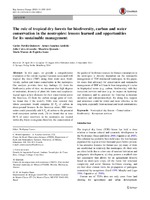Mostrar el registro sencillo del ítem
The role of tropical dry forests for biodiversity, carbon and water conservation in the neotropics: lessons learned and opportunities for its sustainable management
| dc.contributor.author | Portillo-Quintero, Carlos | |
| dc.contributor.author | Sanchez-Azofeifa, Arturo | |
| dc.contributor.author | Calvo-Alvarado, Julio | |
| dc.contributor.author | Quesada, Mauricio | |
| dc.contributor.author | Espirito-Santo, Mario Marcos | |
| dc.date.accessioned | 2017-06-01T22:32:33Z | |
| dc.date.available | 2017-06-01T22:32:33Z | |
| dc.date.issued | 2015-08 | |
| dc.identifier | https://www.scopus.com/inward/record.url?eid=2-s2.0-84937793151&partnerID=40&md5=898ced0054a3d497508b7b78da0375f5 | es |
| dc.identifier | https://link.springer.com/article/10.1007/s10113-014-0689-6 | es |
| dc.identifier.issn | 14363798 | |
| dc.identifier.uri | https://hdl.handle.net/2238/7143 | |
| dc.description.abstract | In this paper, we provide a comprehensive evaluation of the current regional literature associated with tropical dry forest (TDF) along three main axes: biodiversity, carbon and water conservation in the neotropics. Our analysis provides three key findings: (1) from the biodiversity point of view, we document that high degrees of endemism, diversity of plant life forms and ecophysiological types as key elements for their conservation across the Americas, (2) from the carbon storage point of view, we found that if the world’s TDFs were restored they whole ecosystem would comprise 22 Pg of carbon in aboveground biomass. In the Americas alone, TDF restoration could potentially add 8 Pg of carbon to the potential total ecosystem carbon stock, (3) we found that at least 66 % of water reservoirs in the neotropics are located within dry forest ecoregions; therefore, the conservation of the quality of freshwater sources for human consumption in the neotropics is directly dependent on the sustainable management of TDF-dominated landscapes. In this paper, we stress that advocacy for conservation and sustainable management of TDF will benefit from integrating it’s value in biophysical terms (e.g. carbon, biodiversity) with key ecosystem services and uses (e.g. its impact on hydrological dynamics and its potential for fostering ecotourism initiatives and entrepreneurship). By doing this, support and awareness could be wider and more effective in the long term, especially from national and local communities. © 2014, Springer-Verlag Berlin Heidelberg. | es |
| dc.language.iso | eng | es |
| dc.publisher | Springer-Verlag France | es |
| dc.rights | acceso abierto | es |
| dc.rights.uri | https://creativecommons.org/licenses/by-nc/3.0/cr/ | * |
| dc.source | Regional Environmental Change August 2015, Volume 15, Issue 6, pp 1039–1049 | es |
| dc.subject | Biodiversidad | es |
| dc.subject | Conservación | es |
| dc.subject | Ecosistemas | es |
| dc.subject | Research Subject Categories::FORESTRY, AGRICULTURAL SCIENCES and LANDSCAPE PLANNING::Area technology::Forest engineering | es |
| dc.title | The role of tropical dry forests for biodiversity, carbon and water conservation in the neotropics: lessons learned and opportunities for its sustainable management | es |
| dc.type | artículo original | es |
Ficheros en el ítem
Este ítem aparece en la(s) siguiente(s) colección(ones)
-
Artículos [37]



